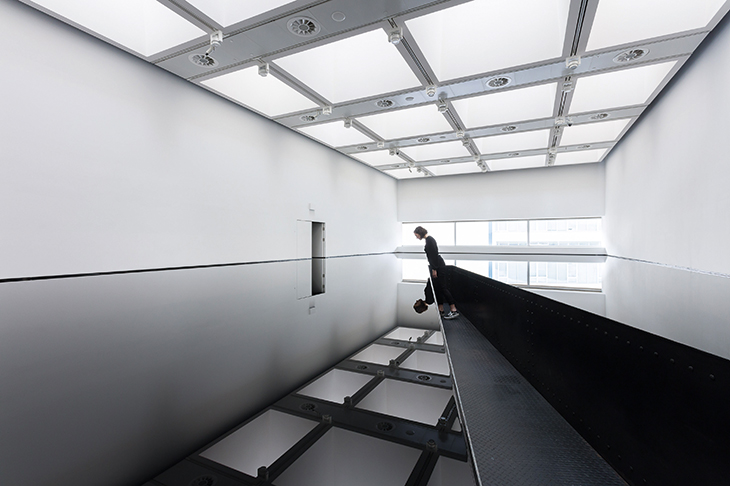A reflection on still water was perhaps the first picture that Homo sapiens ever encountered. The importance of mirrors in the history of art has been underestimated. Alberti, Vasari and Leonardo recommended them as a tool for painters. Van Eyck delighted in them. Caravaggio had one in his studio. And they haven’t stopped fascinating artists. Shape Shifters, the new exhibition at the Hayward Gallery, might as well have been entitled ‘Modern Art through the Looking Glass’.
Consequently, you see yourself all over the show, generally in surprising forms and positions. Early on, for example, you come across Anish Kapoor’s ‘Non-Object (Door)’ (2008), a rectangular block of highly polished stainless steel, each side of which is curved and convex. The result is that, as you approach it, your reflected image — and the surroundings — swirl and fly around. Meanwhile, the work itself, which is, after all, a large metallic object, effectively disappears.
Dematerialisation is, you might think, an unexpected effect for a sculptor to aim at. After all, traditionally, sculpture has been about form, mass and weight. But making solid objects melt away is one of Kapoor’s constant preoccupations. His ‘Sky Mirror, Blue’ (2016), installed on one of the rooftop courts at the Hayward, scoops up the skyline of London, and the clouds above, turns them upside-down and colours them a steely cobalt. Viewed at a distance, from inside the gallery, this is a strangely compelling sight: a cool, contemporary equivalent to the celebrated black obsidian mirror in which the Elizabethan magus Dr John Dee claimed to see spirits.
Reflections can do two intriguing things. They can make what’s really there disappear and, perhaps simultaneously, create a new setting that doesn’t actually exist at all. Richard Wilson’s celebrated piece ‘20: 50’ (1987) does both of these tricks, which adds an undertone of existential threat — and perfectly rational anxiety.
It consists of a huge tank of black recycled engine oil (the title refers to the grade of its viscosity, a particularly thick and glutinous one). You advance into this along a gangway that gets progressively narrower, so that at the end you are standing almost completely surrounded by this dense liquid. You can’t really see it, but — and this is the sinister part — you can certainly smell it.
What you actually see is the top part of the room, reflected in the perfectly smooth surface — a black mirror much better than Dr Dee’s. Like most contemporary art fans, I’ve experienced this piece many times in various iterations of the Saatchi Gallery over the years. Nonetheless, for a second the illusion fooled me. I was visiting the show before the installation was quite complete, and briefly wondered whether the oil had been pumped in yet. Then I realised that what I had assumed was some space below the gallery floor was in fact a vast and faultless reflection of the ceiling.
This work by Wilson — a masterpiece — is sui generis in its injection of a hint of menace (a worry about the consequences if a trailing cuff or scarf were to dip into the art). Most of the pieces on show are more serene, though there is a subtly disquieting quality to Yayoi Kusama’s ‘Narcissus Garden’ (1966–2018). This is another room-filling installation, but rather than thick, inky oil she has covered the floor with shiny metal globes the size of bowling balls. Each of these, the title suggests, is like a tiny mini-you, mirroring the spectator in almost but — because the angle changes — not quite the same way as all the others.
Several of the artists included in the show were based in California in the 1960s and afterwards, and represent a movement or tendency that hasn’t yet been given a satisfactory name. Various tags have been suggested: ‘light and space’, ‘West Coast minimalism’ and, slightly desperately, the ‘LA look’. But none caught on in the way that, say, ‘pop art’ did.
In a way, it’s appropriate that this group, if it was a group, should be nameless, since the works on show by Larry Bell and Robert Irwin are exceptionally elusive. Irwin’s ‘Untitled (Acrylic Column)’, 1969–2011, is close to not being there at all. It’s a long, thin, transparent prism suspended in front of you. The artist calls it an ‘optical instrument’.
When you look through it, what you see is inflected. Only slightly, but enough to suggest that everything we look at is illusory — or is at least created by our sense organs and brains, working together, on the basis of evidence that is always partial and sometimes wrong.
This is also the message of the exhibition. You might complain that there’s almost nothing in the Hayward — just a lot of mirrors and reflections — leaning against the wall, on the floor, in mirror glass mazes, and even carried around by live performers. But that is also the point.






Comments